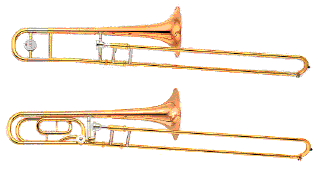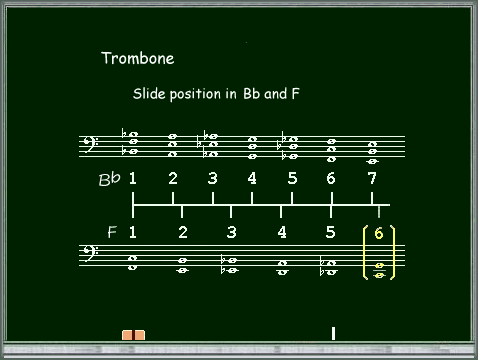The low C
 on a euphonium or the low C
on a euphonium or the low C  on a B¢õtuba will inevitably be too high with 1+3, so if you have an instrument with 4 pistons, try to use 4 as much as possible. Similarly, use 2+4 for the low B a semitone below. The pitch when pressing the 4th piston can be adjusted with the tuning slide of the 4th piston.
on a B¢õtuba will inevitably be too high with 1+3, so if you have an instrument with 4 pistons, try to use 4 as much as possible. Similarly, use 2+4 for the low B a semitone below. The pitch when pressing the 4th piston can be adjusted with the tuning slide of the 4th piston. On the E¢õ bass, play the low F
 with a 4 and the low E
with a 4 and the low E  with a 2+4.
with a 2+4. The written low D
 and D¢õ
and D¢õ  notes on the trumpet and cornet are also higher, but you can adjust this by pull it out a little the 1st and 3rd tuning slides. For more information, see Pitch deviation of brass instruments.
notes on the trumpet and cornet are also higher, but you can adjust this by pull it out a little the 1st and 3rd tuning slides. For more information, see Pitch deviation of brass instruments.In French horn, even if you are using the B¢õ side of a double horn, when the fingering 1+3 or 1+2+3 to play poorly tuned (high) notes, you can use fingering 0 or 2 on the F side.
B¢õside
 ¡¢same note for F side
¡¢same note for F side
The F attachment on the trombone is the same as the 4th piston.
The trombone above is a trombone without a F attachment. The trombone below is a trombone with a F attachment.

If the instrument has the same bore as a tenor, it is still a tenor even if it has an F attachment. In Japan, tenors with an F attachment are sometimes called a tenor bass trombone.
The length of the tube is the same for both tenor with an F attachment and bass, so the range and positions are the same.
By pressing the lever of the left thumb, you can play the notes in 6th position without reaching out and can play a low C
 in 1st position (though fine tuning of the pitch is necessary).
in 1st position (though fine tuning of the pitch is necessary). However, when a F attachment is used, since the length of the entire instrument becomes longer, the distance between each position (a semitone) also becomes longer. B
 a semitone lower, is slightly farther away than the 2nd position of a B¢õ, but this is the 2nd position of an F side.
a semitone lower, is slightly farther away than the 2nd position of a B¢õ, but this is the 2nd position of an F side. The pitch of the trombone can be freely adjusted with the slide, so you can play a low D¢õ
 on an F attachment. This D¢õ can be played in almost the same position as the 6th position of a B¢õ, but it is the 5th position of an F. The relative positions of the B¢õ and F tubes are roughly as shown in the following diagram.
on an F attachment. This D¢õ can be played in almost the same position as the 6th position of a B¢õ, but it is the 5th position of an F. The relative positions of the B¢õ and F tubes are roughly as shown in the following diagram. 
 and F
and F (Depending on the instrument). If you tune F with the slide all the way in, you will probably need to pull the slide out about 2 cm to tune C.
(Depending on the instrument). If you tune F with the slide all the way in, you will probably need to pull the slide out about 2 cm to tune C. The 6th position of the F tube is farther away than the 7th position of the B¢õ tube, and even if you reach the end of the slide the pitch is still high, so it's better to think of the F tube as being limited to 5th position.
If a low C
 or B
or B is needed, a bass trombone with two rotary valves is used, but the instrument is quite heavy and the two rotary keys must be operated with the fingers of the left hand holding the instrument, so it may be difficult for elementary school students.
is needed, a bass trombone with two rotary valves is used, but the instrument is quite heavy and the two rotary keys must be operated with the fingers of the left hand holding the instrument, so it may be difficult for elementary school students. As an aside, sometimes a bass trombone with one rotary is played a high part without knowing that it is a bass trombone. At one junior high school, a bass trombone with two rotary was used for the first part because it looked more expensive.
There are several different bore sizes for tenor trombones, each with its own characteristics, so they are used according to the music being played. Generally, jazz and other music are played with small bore, while modern classical orchestras use large bore. I think that an instrument with a smaller bore size is easier for elementary school students to use.
Other brass instruments are also divided into small and large bores, but in the case of trombones, there are also differences in the mouthpieces that can be used for small and large bore horns.